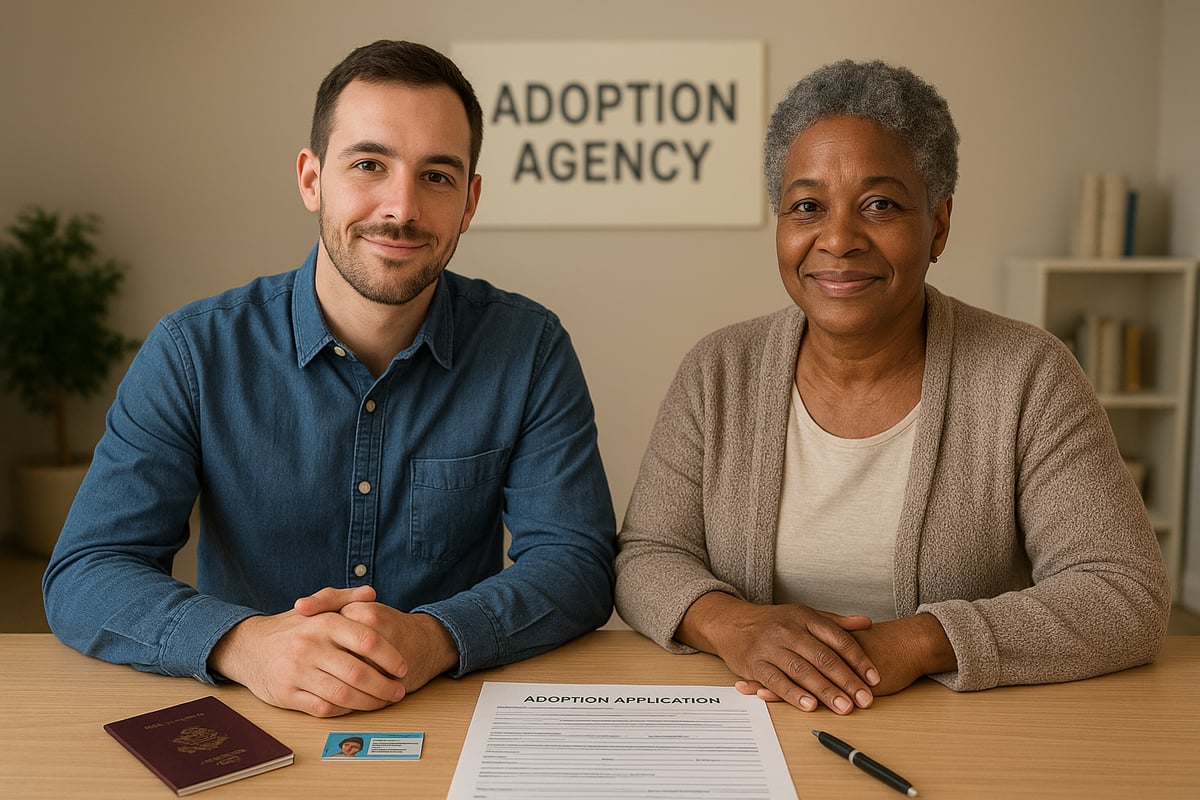
Age Restrictions on Adoption: The Essential Guide 2025
Dreaming of building your family but feeling overwhelmed by the maze of age restrictions on adoption? You are not alone. Many hopeful parents face confusing rules that can make the process feel daunting.
This essential 2025 guide is here to clear the fog. Discover the real reasons behind age restrictions on adoption, learn how rules vary across the world, and get the latest legal updates. Find out about exceptions, practical tips, and what you can do next to move closer to parenthood.
Let’s break down the barriers together and help you take your first confident step toward adopting a child.
Understanding Age Restrictions in Adoption
Navigating age restrictions on adoption can feel like walking through a maze. Parents often wonder why these rules exist, how agencies set them, and whether exceptions are possible. Understanding this landscape will empower you to take confident steps toward building your family.

The Purpose Behind Age Limits
Agencies set age restrictions on adoption to protect child welfare and ensure parents are ready for the demands of parenting. These rules balance life expectancy with a child's long-term needs. Social and psychological factors also play a role, as agencies want to match children with stable, age-appropriate caregivers.
For example, the majority of U.S. agencies require adoptive parents to be at least 21 years old. Data shows that 80 percent of agencies enforce minimum age requirements. These rules are designed to promote the best outcomes for both children and families.
Minimum and Maximum Age Requirements
Minimum and maximum age requirements for adoption vary widely. In the U.S., domestic adoptions typically require parents to be between 21 and 50, while international programs may allow up to 55. These age restrictions on adoption can differ by agency, state, or country.
For instance, China sets a maximum age of 50 for women and 55 for men in international adoptions. Some agencies are more flexible, especially for special cases or harder-to-place children. Understanding these limits is crucial for planning your adoption journey.
| Country/Type | Minimum Age | Maximum Age |
|---|---|---|
| U.S. Domestic | 21 | 50 |
| China (Intl) | 30 | 50 (W), 55 (M) |
| India (Intl) | 25 | 55 |
How Age is Calculated and Verified
Agencies verify age using official documents like birth certificates or government IDs. The age restrictions on adoption may be based on your age at the time of application or at the time of child placement, depending on the agency's policy.
Some organizations use the age listed during the home study process. If you want to learn more about this critical step, the home study process for adoption goes in-depth on how agencies assess eligibility, including age.
The Rationale for Age Gaps Between Parent and Child
Most agencies require a minimum age gap between parent and child, often 15 to 18 years, to ensure generational appropriateness. This aspect of age restrictions on adoption helps agencies match children with parents who can realistically fulfill the parental role.
There are exceptions, especially in stepparent or kinship adoptions, where the focus shifts to the strength and stability of the existing relationship. The goal is always to support the child's long-term well-being.
Age Restrictions for Couples vs. Single Applicants
Policies often differ for married couples and single applicants. Some countries prohibit single-parent adoptions above a certain age, while others have more lenient rules for couples. Single parents may face unique challenges but also find opportunities, especially when adopting older children or those with special needs.
Agencies will assess each applicant's overall readiness, taking age into account but also considering support networks and life circumstances.
Historical Changes and Trends
Attitudes toward age restrictions on adoption have shifted over the years. More agencies now recognize the value older parents bring, especially for children who are harder to place. Policy reforms in recent years have raised upper age limits in several regions.
For example, in 2023, there was a 10 percent increase in adoptions by parents over 45. These changes reflect a growing understanding that suitability for adoption goes beyond just age.
Age Restrictions by Adoption Type
Choosing the right adoption path means understanding how age restrictions on adoption can vary dramatically by type. Whether you are considering domestic, foster care, international, or kinship adoption, knowing the rules upfront saves time and frustration. For a deeper dive into how these adoption types compare, including their distinct age requirements, see this helpful Differences between adoption types guide.

Domestic Infant Adoption
Domestic infant adoption is popular among families seeking to adopt a newborn. Here, age restrictions on adoption typically require prospective parents to be at least 21, with most agencies preferring an upper age limit between 40 and 45. However, these numbers are not set in stone. Private agencies may have their own policies, and state regulations might differ. For example, some agencies show a strong preference for parents under 40, believing younger parents provide greater long-term stability.
Still, exceptions exist. If a prospective parent can show strong support systems or past parenting experience, agencies sometimes offer flexibility. The median age of adoptive parents in domestic infant cases is 37, reflecting these trends. Understanding the nuances of age restrictions on adoption in this category is crucial for planning your journey.
Foster Care Adoption
Foster care adoption stands out for its more flexible approach to age restrictions on adoption. Most states require adoptive parents to be at least 21, but there is rarely a firm upper age limit. Instead, agencies focus on the applicant’s ability to meet a child’s needs. Some states even offer waivers for kinship caregivers, allowing grandparents or older relatives to adopt despite exceeding typical age ranges.
This path is ideal for older applicants or those with significant life experience. Age restrictions on adoption in foster care are more about suitability and readiness than strict numbers. State-specific exceptions and waivers are common, making foster care adoption accessible to a wider age range.
International Adoption
International adoption introduces another layer of complexity to age restrictions on adoption. Each country sets its own minimum and maximum ages, often with strict guidelines. For instance, China requires women to be under 50 and men under 55, while India allows couples up to age 55. Agencies will carefully verify age with legal documents and may require a minimum age gap between parent and child.
Paperwork is crucial. Prospective parents must provide birth certificates, passports, and other documents to confirm compliance. The age restrictions on adoption internationally can be rigid, so researching each country’s rules before applying is essential.
Stepparent and Kinship Adoption
Stepparent and kinship adoptions offer the most flexibility regarding age restrictions on adoption. Courts and agencies recognize the importance of maintaining family connections, so age requirements are often relaxed. The focus shifts to the stability of the relationship and the best interests of the child.
In many cases, younger stepparents or older relatives can adopt with minimal legal hurdles. Courts have discretion to approve exceptions, especially when the child already has a strong bond with the prospective parent. Age restrictions on adoption in these cases are more about safeguarding the child’s welfare than enforcing a particular number.
Special Needs and Sibling Group Adoption
Adopting special needs children or sibling groups often comes with relaxed age restrictions on adoption. Agencies recognize that these children are harder to place and may actively seek out older, more experienced parents. Incentives such as reduced fees or expedited processing may be offered to encourage qualified applicants.
Flexibility is the norm. For sibling groups, agencies may waive maximum age limits if the parents demonstrate the ability to provide a stable, loving home. Age restrictions on adoption are applied with compassion in these cases, prioritizing the child’s need for permanency over rigid rules.
Legal Framework and Recent Changes in 2025
Understanding the legal landscape is crucial for anyone navigating age restrictions on adoption. Laws and policies are continually evolving, so staying informed will empower you to make confident choices. In 2025, significant updates are shaping who can adopt and how age is considered across different jurisdictions.

Federal and State Laws in the U.S.
When it comes to age restrictions on adoption, both federal and state laws play important roles. The federal government sets broad guidelines, but each state can establish its own specific requirements.
For example, most states require adoptive parents to be at least 21 years old. Some states, like Indiana, have unique legal considerations that can impact age eligibility. Upper age limits are less common but may exist within certain public or private agencies.
States like Texas and California differ in their interpretation and enforcement of age restrictions on adoption. Texas might allow more flexibility, while California often maintains stricter guidelines. Always verify your state’s current laws before starting the adoption journey.
International Conventions and Treaties
International adoption brings another layer of complexity to age restrictions on adoption. Treaties like the Hague Adoption Convention standardize certain requirements, but each country still sets its own rules.
For instance, some countries require adoptive parents to be within a specific age range, often with a minimum and maximum. The UN Report on Child Adoption details how global frameworks influence these age requirements and the rationale behind them.
Hague-compliant countries tend to have more transparent processes regarding age restrictions on adoption. Non-compliant countries may have less predictability, so prospective parents should research each nation’s policies carefully.
Notable Legal Updates for 2025
This year, several states and countries have revised their age restrictions on adoption. For example, New York raised its maximum adoptive parent age to 55, reflecting a trend toward inclusivity.
Agencies are now providing clearer guidance on how age factors into eligibility. Some reforms aim to address the needs of older hopeful parents, while others clarify exceptions for kinship or special needs adoptions.
These changes underscore the importance of staying informed about current age restrictions on adoption. Regularly check for updates in your jurisdiction to avoid surprises during the process.
Exceptions, Waivers, and Appeals
Not all age restrictions on adoption are absolute. Many legal systems provide pathways for exceptions, waivers, or appeals.
Judges and agencies often have discretion to grant waivers, especially in cases where the child’s best interests are clear. For example, kinship caregivers or stepparents may receive exceptions even if they fall outside standard age limits.
To pursue a waiver, you’ll typically need to present compelling evidence, such as medical clearances or letters of recommendation. Understanding the appeals process can help you advocate for your case if you encounter age-related barriers.
Documentation and Compliance
Verifying and documenting your age is a fundamental part of meeting age restrictions on adoption. Agencies require official documents, like birth certificates or government-issued IDs, to confirm eligibility.
Falsifying age information can lead to severe consequences, including disqualification from the process. Agencies are responsible for monitoring compliance and ensuring all legal standards are met.
Stay organized and proactive by preparing all necessary paperwork early. This approach not only helps you meet age restrictions on adoption but also keeps your adoption journey on track and stress-free.
Navigating the Adoption Process with Age Restrictions
Embarking on the adoption journey can be both exciting and daunting, especially when age restrictions on adoption come into play. Understanding each step of the process and how age requirements factor in will help you move forward with confidence and clarity.

Step 1: Researching Eligibility
The first step in navigating age restrictions on adoption is to assess your eligibility. Start by checking both agency and government websites for current age requirements. Many agencies offer online quizzes to help you quickly gauge your fit.
If you are considering adopting in a specific state, take time to review local laws. For instance, Indiana adoption legal considerations provide a detailed look at state-specific rules, including age requirements. This research ensures you do not waste time applying where you may not qualify.
Remember, every adoption path has its own age restrictions on adoption, so being informed early saves frustration later.
Step 2: Selecting the Right Adoption Path
Once you understand the age restrictions on adoption that apply to you, it is time to choose the best path. Domestic infant, foster care, and international adoptions each have different age rules. For example, foster care may welcome older applicants, while private agencies might prefer younger parents.
Consulting with adoption professionals can help you match your profile to the right type of adoption. Some older applicants find that foster care or special needs adoptions are more accessible. Exploring all your options ensures you align your goals with the realities of age restrictions on adoption.
Step 3: Completing Home Study and Age Verification
Completing a home study is a universal requirement, and this is where age restrictions on adoption are formally verified. Be prepared to provide legal documents like birth certificates and government IDs.
During the home study, agencies assess your overall readiness, not just your age. They may consider your health, support network, and stability. Make sure your documentation is accurate and up to date, as agencies need to confirm you meet the age restrictions on adoption before moving forward.
Step 4: Preparing for Possible Exceptions or Appeals
If you discover that you are just outside the age restrictions on adoption, do not lose hope. Many agencies and courts will consider waivers for compelling cases. For example, kinship or special needs adoptions may offer more flexibility.
To strengthen your appeal, gather strong letters of recommendation and medical clearances. Agencies want to see that you are healthy, stable, and have a strong support system. Understanding how to navigate exceptions ensures you can still pursue adoption, even if age restrictions on adoption seem like a barrier.
Step 5: Understanding Impact on Wait Times and Matching
Age restrictions on adoption can affect how long you wait to be matched with a child. For instance, younger applicants may have shorter wait times for infant adoptions, while older applicants might wait longer or be matched with older children.
To improve your prospects, consider broadening your preferences, such as being open to siblings or children with special needs. Agencies appreciate flexibility and may prioritize applicants who are willing to consider a wider range of children. Recognizing how age restrictions on adoption influence matching helps you set realistic expectations.
Step 6: Ongoing Support and Resources for Older Adoptive Parents
After placement, ongoing support is vital, especially for those navigating age restrictions on adoption. Many organizations offer counseling, support groups, and resources specifically for older or younger adoptive parents.
Connecting with national support networks can help you manage age-related challenges, such as energy levels or generational differences. Do not hesitate to seek help—these resources are designed to help families thrive, regardless of the age restrictions on adoption they faced during the process.
Common Myths and Misconceptions About Age Restrictions {400}
Misunderstandings about age restrictions on adoption often discourage qualified parents from pursuing their dream of building a family. Let’s unravel the truth behind the most persistent myths, so you can confidently move forward in your adoption journey.
Myth 1: There’s a Universal Age Limit for Adoption
Many believe there is a single, global rule for age restrictions on adoption. In reality, requirements differ significantly based on country, state, and agency. For example, the U.S. often sets the minimum age at 21, while the U.K. minimum is 18. Some international programs have their own unique standards.
This misconception can cause confusion and needless worry. For a deeper look at the variety of policies, check out Common adoption myths debunked. Understanding the landscape empowers you to find the path that matches your circumstances.
Myth 2: Older Adults Can’t Adopt
Another common myth is that older adults are not allowed to adopt, which is simply not true. Many agencies actively welcome older parents, especially for children who are older themselves or part of sibling groups. In fact, age restrictions on adoption often become more flexible if you are open to fostering or adopting children with special needs.
Recent data shows that 15% of U.S. adoptions in 2023 involved parents over 50. Agencies tend to focus on health, stability, and support, not just age. If you are an older adult considering adoption, your experience and maturity can be a significant asset.
Myth 3: Age Is the Only Factor That Matters
It’s easy to assume that age restrictions on adoption are the sole hurdle, but agencies look at the bigger picture. Factors like your health, financial stability, and support network are just as important—sometimes more so. For example, a younger applicant might be declined if they lack a stable living situation or steady income.
Adoption professionals want to ensure the best possible outcome for the child. Age is a guideline, not the only determinant. By focusing on your overall readiness, you can strengthen your application and improve your chances.
Myth 4: Age Restrictions Are Set in Stone
Some believe that age restrictions on adoption are unchangeable. In practice, many agencies and courts allow for exceptions, especially in cases of kinship or stepparent adoptions. If you can demonstrate strong support, good health, and a compelling reason, waivers may be granted.
There are real stories of families successfully appealing age limits, particularly when the child’s best interests are at stake. It’s worth exploring your options before assuming you’re ineligible.
Myth 5: Age Limits Are Discriminatory
A final misconception is that age restrictions on adoption exist to exclude or discriminate. In truth, these policies are designed to protect the welfare of the child, ensuring parents are ready and able to provide care throughout the child’s formative years.
Legal and ethical reviews consistently support age guidelines as tools for child safety, not exclusion. If you have concerns about fairness, consult with professionals who can explain the reasoning and help you navigate the system.
Frequently Asked Questions About Age Restrictions on Adoption
Thinking about adoption and wondering how your age might affect your journey? You are not alone. Below, we answer the most common questions about age restrictions on adoption, giving you the clarity and confidence you need to move forward.
What is the minimum and maximum age to adopt in the U.S.?
Most U.S. states and agencies set the minimum age for adoption at 21. However, the maximum age varies widely. Some agencies may not have a strict upper age limit, while others cap eligibility between 45 and 55, especially for certain types of adoption. For example, international programs often set their own age boundaries based on country-specific rules.
Here is a quick summary:
| Adoption Type | Minimum Age | Maximum Age |
|---|---|---|
| Domestic Infant | 21 | 45-50 |
| Foster Care | 21 | Flexible |
| International | 25 | 50-55 |
Requirements can shift based on your state or the agency you choose. If you want to see the latest trends, the Adoption Statistics Overview provides valuable insights into age patterns and recent changes for adoptive parents. Remember, age restrictions on adoption are there to support the best interests of the child.
Can single people of any age adopt?
Single applicants are welcome in many adoption programs, but policies can differ. Some agencies require single adoptive parents to meet a higher minimum age, such as 25 or 30. Others may set no upper age limit but look closely at the applicant’s health, stability, and support network.
It is important to review each agency’s requirements. Some countries, for example, restrict single-parent adoptions or set different age rules for singles. These age restrictions on adoption aim to ensure that every child is placed in a stable, loving home, regardless of the parent's relationship status.
Don’t let single status discourage you. Many single parents have successfully adopted, especially through foster care or kinship placements. With the right preparation, you can navigate the process confidently.
Are there exceptions to age requirements?
Yes, exceptions do exist. Many agencies and courts allow for age waivers in special circumstances. For example, if you are adopting a relative (kinship adoption) or a child with special needs, age restrictions on adoption may be relaxed.
To request an exception, you typically need to:
- Submit a formal appeal or waiver request
- Provide supporting documentation, such as medical clearances
- Offer references or letters of recommendation
Judges and agencies have the discretion to approve these exceptions, especially when it serves the child’s best interests. If you believe you have a strong case, do not hesitate to ask about the waiver process early on.
How does age impact the adoption process and wait times?
Your age can influence both your eligibility and your wait time. Younger applicants may have more options for infant adoption, while older applicants are often prioritized for older children, sibling groups, or special needs placements.
Agencies may place older applicants lower on the infant adoption waitlist, but they are often encouraged to consider foster care or older child adoption. According to the Adoption Statistics Overview, the median age of adoptive parents in the U.S. is 37, but there is a growing trend of successful adoptions by parents over 45.
Age restrictions on adoption are designed to create the best matches for children and families. Flexibility increases for hard-to-place children, so do not let age alone deter you from exploring all options.
What support is available for older or younger adoptive parents?
Support is available at every stage of the journey. Many agencies offer counseling, support groups, and educational resources tailored for both older and younger adoptive parents. National organizations and online communities can connect you with others who have navigated similar age restrictions on adoption.
For example, some support networks focus on parents over 40, providing mentorship, advice, and social opportunities. Younger applicants can also find resources that address unique challenges, such as building a support system or balancing career and parenthood.
Whether you are just beginning or already matched, these resources make it easier to thrive as an adoptive parent—no matter your age.
You’ve just learned how age restrictions can shape every step of the adoption journey, from eligibility to the matching process. If you’re feeling inspired to move forward but aren’t sure where to start—or want to make the process a little easier—here’s something just for you. We know the home study is a major milestone, and every bit of support helps. That’s why we’re offering you $100 off the cost of your home study. This is your chance to take the next step toward building your family with confidence. Claim your savings here: $100 Off Cost of Home Study


